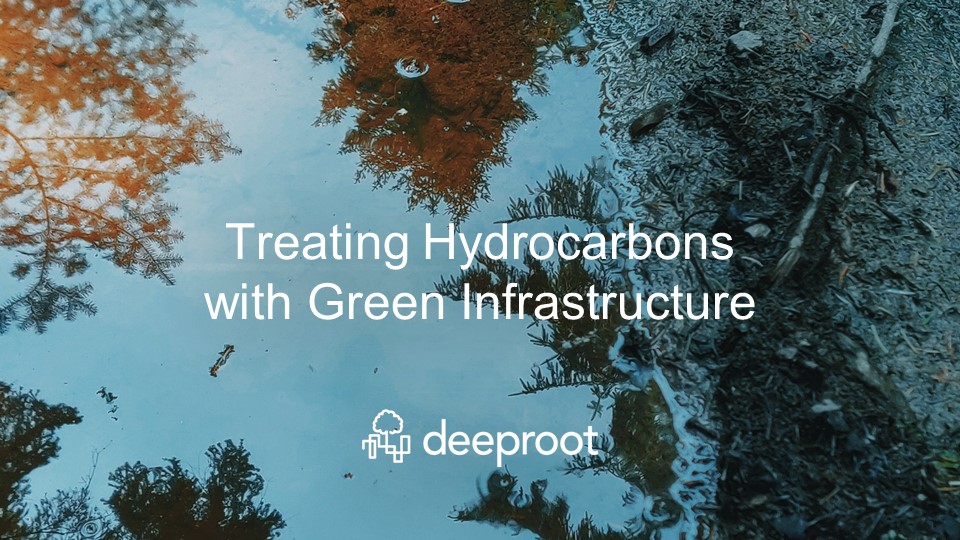I’ve always believed in nature’s processes to manage compounds in the environment. Even as a young undergraduate engineer, I often wondered why we are removing natural systems like trees and soil rather than working with them, why we weren’t protecting and bolstering those systems in ways that enhanced their natural mitigating processes.
The (relatively) recent trend in using green infrastructure to manage stormwater is a step in that direction. Of particular interest are bioretention facilities and soils that are deployed in our highly urban environments and adjacent to streets with the intent to manage stormwater runoff from our roadways which is contaminated with all sorts of pollutants, including hydrocarbons. The question is, can these man-made “natural” systems effectively treat hydrocarbons in the captured stormwater. The answer is yes, very effectively.
Soil and plants remove pollutants from stormwater through several processes: filtration, sedimentation, adsorption, plant uptake and microbial degradation. Depending on the pollutant, each mechanism is more or less important and the effectiveness of removal is dependent on a lot of factors, including (but not limited to) soil composition, loading rate, maturity of the system and concentration of pollutant.
The most relevant of these processes to hydrocarbon removal are filtration, adsorption, microbial degradation and phytoremediation.
Filtration is the mechanism of physical removal of contaminates through the separation of solids from liquids by passing through a porous material, in the case of bioretention facilities, the porous material are the mulch and soil layers. Filtration is particularly important for hydrocarbon removal since they preferentially attach to particles in stormwater, or suspended solids. Filtration is considered the primary method of total suspended solids (TSS) removal and since hydrocarbons tend to prefer to adsorb to particles rather than being in aqueous solution, removal of TSS targets hydrocarbon removal.
Adsorption is the attachment of contaminates to the surface of soil media particles. Good choice of soil composition considers adequate and preferential adsorption media. Adequate and preferential refers to having sufficient soil particle surface area for the given contaminate concentration, such as clay, and preferential refers to the right ionic charge (cation exchange capacity in soils like clays) and organic content. The amount of a high clay content must be balanced with the overall porosity of the soil since too much clay content can cause clogging or soil cracking when the soil dries out making channels for stormwater to pass through without being properly filtered.
Microbial degradation is the digestion or other breakdown of the hydrocarbons by microorganisms in the soil, either by direct degradation from the filtering stormwater or degradation of the hydrocarbons adsorbed to the surface of the soil media.
Last, but not least, phytoremediation is plant-supported degradation of pollutants. There are multiple systems acting in phytoremediation including plant uptake, stabilization and degradation within the plant structure and root-zone degradation through rhizosphere biodegradation (plant excretion enhanced microbial biodegradation). These process result in ranges of as much as 99% reduction in hydrocarbon concentrations in an University of New Hampshire study and 87% in a University of Copenhagen study.
Soil and plant composition are the main factors that influence the effectiveness of these processes. Soil composition is particularly important as it supports, or inhibits, all the processes that are critical for hydrocarbon (and other pollutant) removal and degradation. Generally soil composition in stormwater projects is a sandy loam (or a blend of sandy loam with sand and/or compost) and a 2” to 6” (5 cm to 15 cm) deep mulch layer on top. The sandy loam layer typically ranges between 12” to 30” (30.5 cm to 76 cm) deep and consists of 55-90% sand, 0-35% silt and 0-20% clay from a soil classification perspective. For hydrocarbon removal, a soil blend with high adsorptive potential (higher clay and organic content) is important. Organic content supports good microbial growth which supports biodegradation of hydrocarbons and good plant growth which also supports microbial degradation and phytoremediation processes. Similarly, the mulch layer (high organic content, supportive of microbial growth and adsorption) provides removal and degradation of hydrocarbons.
Plants also contribute significantly to the success of bioretention facilities. Simple comparisons of stormwater facilities demonstrate this over and over again. For example, wet ponds show buildup of contaminants in the pond bottom soils while planted bioretention facilities show degradation of hydrocarbons. Together, soil media and plants are shown to be significantly more effective than other BMPs (i.e. stormwater ponds) in removal and biodegradation of hydrocarbons.
Stormwater can contain many contaminants that are important to consider for your particular project site. As far as hydrocarbons are concerned, studies are clear that green infrastructure solutions that incorporate soil and plants are very effective at treatment and removal.
Sources
Austin, Gary. “Design And Performance Of Bioretention Beds For Removal Of Stormwater Contaminants.”
Bakacs, Michele et al. “Assessment of Car Wash Runoff Treatment Using Bioretention Mesocosms.”
Center for Public Environmental Oversight. “Phytoremediation.”
Dehais, Mary. “Bioretention: Evaluating their Effectiveness for Improving Water Quality in New England Urban Environments.”
Liu, Jai, et al. “Review and Research Needs of Bioretention Used for the Treatment of Urban Stormwater”
Minnesota Stomrwater Manual: Operation and Maintenance of Bioretention
Washington State Department of Transportation. “BMP Effectiveness Assessment for Highway Runoff in Western Washington.”
Patty Buchanan is a civil engineer at MIG|SvR.






Leave Your Comment